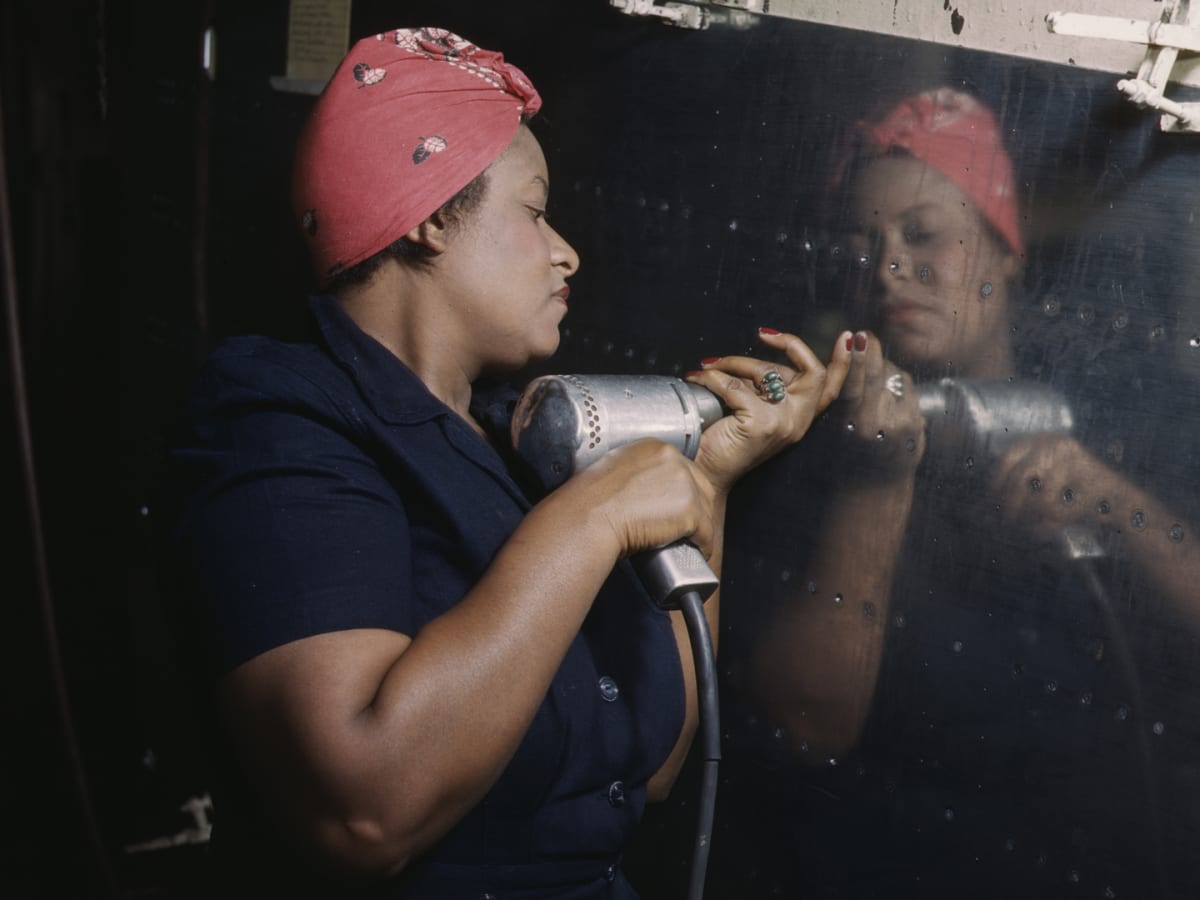By Aaron Randle
From shipyards to factories to government administrative offices, Black women worked to battle authoritarianism abroad and racism at home.
Rosie the Riveter—the steely-eyed World War II heroine with her red bandanna, blue coveralls and flexed bicep—stands as one of America’s most indelible military images. Positioned under the maxim “We Can Do It,” the “Rosie” image has come to broadly represent the steadfast American working woman, and more specifically, the millions of female laborers who kept the factories and offices of the U.S. defense industries humming.
What the iconic Rosie image doesn’t convey is the diversity of that work force—specifically the more than half-million “Black Rosies” who worked alongside their white counterparts in the war effort. Coming from throughout the United States, these “Black Rosies” worked tirelessly—in shipyards and factories, along railroads, inside administrative offices and elsewhere—to fight both the foreign enemy of authoritarianism abroad and the familiar enemy of racism at home. For decades, they received little historical recognition or acknowledgement.
Economic Opportunity Beckoned

African American female riveter sitting on huge piece of machinery during WWII at Lockheed Aircraft Corp., 1942.
Like the Great War before it, World War II had required participating nations’ entire populations to contribute to the war effort. Once the U.S. entered the conflict in 1941 and millions of American men were enlisted into the military, the government had to rely on American women to fill domestic war-related roles. At the peak of the wartime industrial production, some 2 million women worked in war-related industries.
For African American women, becoming a Rosie was not only an opportunity to aid in the war effort, but also a chance for economic empowerment. Already on the move as part of the Great Migration, they sought to leave behind dead-end, often demeaning work as domestics and sharecroppers.
“Black people were leaving the south anyway and fanning out across the country,” says Gregory S. Cooke, director of Invisible Warriors, a documentary on the Black Rosies. “The war gave the women a more pointed motivation for leaving and an opportunity to make money in ways Black women had never dreamed before.”
President Roosevelt Intervenes to Address Workplace Inequity

Welders prepare to work on SS George Washington Carver in Richmond, California, 1943.
E. F. Joseph/Anthony Potter Collection/Getty Images
At first, finding war-related work proved difficult for many prospective Black Rosies, as many employers—almost always white men—refused to hire Black women.
“The war represented this incredible opportunity, but Black women really had to rally and fight for the opportunity to even be considered,” says Dr. Maureen Honey, author of Bitter Fruit: African American Women in World War II and emeritus professor of women’s and gender studies at the University of Nebraska–Lincoln. “Many employers held out, attempting to only hire white women or white men, until they were forced to do otherwise.” That coercion came in the summer of 1941 when activists Mary McLeod Bethune and A. Phillip Randolph brought the widespread hiring discrimination to President Franklin Roosevelt, prompting the Commander-in-Chief to sign Executive Order 8802 banning racial discrimination in the defense industry. The order boosted Black women’s entry into the war effort; of the 1 million African Americans who entered paid service for the first time following 8802’s signing, 600,000 were women.
The roles Black Rosies played in the war effort ran the gamut. They worked in factories as sheet metal workers and munitions and explosive assemblers; in navy yards as shipbuilders and along assembly lines as electricians. They were administrators, welders, railroad conductors and more.
“It was work that you were proud of,” says Ruth Wilson, a 98-year-old Black Rosie living in Philadelphia.
During the war, Mrs. Wilson left her job as a domestic and became a sheet metal worker at the Philadelphia Navy Yard, where she worked on the yard’s dry dock assembling ship bulkheads. “It made me feel good because my husband was over there in Europe fighting, and here I was doing my part,” Ms. Wilson said. Plus, she said, “I made more money!”
An Uphill Fight

A lathe operator at an aircraft manufacturing plant in Milwaukee, Wisconsin, 1942.
Universal History Archive/Getty Images
Yet, despite their importance, Black Rosies still faced biting racism and sexism on the home front.
Both Black and white women were routinely paid 10 to 15 cents an hour lower than their male counterparts, despite equal pay regulations. Across the nation, Black workers received fewer benefits and were barred from controlling any union activities, with the shipbuilder’s union blocking Black people from membership altogether. And at Wagner Electric, a factory in St. Louis, despite a diverse workforce composed of 64 percent white women and 24 percent Black men, no Black women were hired.
“These struggles were a part of the Double V campaign,” says Dr. Honey, denoting the slogan used during World War II highlighting the struggle on two fronts that Black Americans found themselves fighting—for victory over freedom overseas and for victory over oppression at home.

